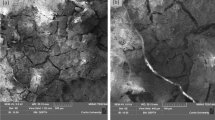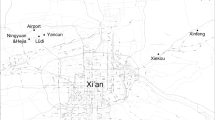Abstract
In this article, metallurgical aspects of a 17th century forge-welded iron cannon at Thanjavur are addressed, including an analysis of manufacturing methodology based on careful observation of its constructional details. Microstructural examination of iron from the cannon reveals that the iron was extracted from ore by the direct process. Thus, the cannon was fabricated by forge welding and not by casting. Electrochemical polarization studies indicate that the corrosion rate of the cannon iron can be compared to that of 0.05% carbon mild steel under complete immersion conditions. However, the atmospheric corrosion resistance of the cannon is far superior to that of modern steel and can be attributed to the formation of an adherent protective passive film. It is concluded that this cannon constitutes a marvel of medieval Indian metallurgical skill.
Similar content being viewed by others
References
P. Neogi, Iron in Ancient India (Calcutta, India: Indian Association for Cultivation of Science, 1914), pp. 32–40.
C. Ritter von Schwarz, “Uber die Eisen und Stahlindustrie Ostindiens (About the Iron and Steel Industry of East India),” Stahl und Eisen, 21 (1901), pp. 209–211, 277–283.
K. Roessler, “The Big Cannon Pipe at Tanjavur,” Metal News, 19 (1) (1997), pp. 1–4.
R. Kannan and R. Balasubramanian, Documentation on the Cannons in the Government Museum Chennai (Madras) (Chennai, India: Government Museum, 2000).
T.R. Anantharaman, The Rustless Wonder—A Study of the Iron Pillar at Delhi (New Delhi, India: Vigyan Prasar, 1996), pp. 11–87.
R. Balasubramaniam, Delhi Iron Pillar—New Insights (Shimla, India: Indian Institute of Advanced Study, 2002), pp. 3–88.
R. Smith and R. Brown, Bombards Mons Meg and Her Sisters (England: Royal Armouries, The Dorset Press, 1989).
P. Benoit, P. Dillmann, and P Fluzin, Iron, Cast Iron and Bronze: New Approach of the Artillery History in Importance of Ironmaking (Norberg, Jernkontoret, Stockholm: Jernkontoret, 1996), pp. 241–257.
D. Nissel, “Zur Konstruktion und Geschichte der Dresdener Faulen Magd (About the Construction and History of the Lazy Maid of Dresden),” Festundgsforschund, Bd 111, (Wessel, 1992).
K. Balasubramaniam, Thanjavur (600 A.D.—1850 A.D.) (in Tamil) (Thanjavur, India: Anjana Publications, 1994), pp. 312–337.
A.K. Biswas, “Minerals and Metals in Medieval India,” History of Indian Science, Technology and Culture, A.D. 1000-1800, ed. A. Rahman (New Delhi, India: Oxford University Press, 1999), pp. 275–313.
R. Balasubramaniam and K. Bhattacharya, “Dal Mardan—The Medieval Forge Welded Iron Cannon at Bishnupur,” to be published.
Vikas Kumar and R. Balasubramaniam, “On the Origin of High Phosphorus Content in Ancient Indian Iron,” Int. Journal of Metals, Materials and Processes, 14 (2002), pp. 1–14.
P. Piccardo et al., “Detecting Non-Uniform Phosphorus Distribution in Ancient Indian Iron by Color Metallography,” to be published.
C. Leygraf, “Atmospheric Corrosion,” Corrosion Mechanisms in Theory and Practice, Second Edition, ed. P. Marcus (New York: Marcel Dekker, 2002), pp. 529–562.
R.A. Nyquist and R.A. Kagel, editors, IR Spectra of Inorganic Compounds (New York: Academic Press, 1971).
R. Balasubramaniam and A.V. Ramesh Kumar, “Characterization of Delhi Iron Pillar Rust by X-ray Diffraction, Fourier Infrared Spectroscopy and Mössbauer Spectroscopy,” Corrosion Science, 42 (2000), pp. 2085–2101.
P. Dillmann et al., “Microdiffraction Coupled with X-ray Fluorescence Microprobe: Application in Archaeometry,” Journal of Trace and Microprobe Techniques, 15 (1997), pp. 251–262.
P. Dillmann, R. Balasubramaniam, and G. Beranger, “Characterization of Protective Rust on Ancient Indian Iron using Microprobe Analyses,” Corrosion Science, 44 (2002), pp. 2231–2242.
Author information
Authors and Affiliations
Additional information
For more information, contact R. Balasubramaniam, Indian Institute of Technology, Kanpur, Department of Materials and Metallurgical Engineering, Kanpur 208 016, India
Tanjore r. Anantharaman is a retired professor currently with Ashram Atmadeep. S. Reguer is a Ph.D. student and P. Dillmann is an engineer at CEA/CNRS.
Rights and permissions
About this article
Cite this article
Balasubramaniam, R., Saxena, A., Anantharaman, T.R. et al. A marvel of medieval Indian metallurgy: Thanjavur’s forge-welded iron cannon. JOM 56, 17–23 (2004). https://doi.org/10.1007/s11837-004-0265-5
Issue Date:
DOI: https://doi.org/10.1007/s11837-004-0265-5




